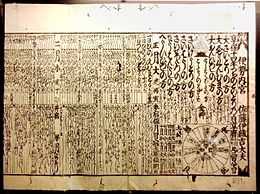Jōkyō calendar
From Wikipedia, the free encyclopedia

Jōkyō calendar published in 1729. Exhibit in the National Museum of Nature and Science, Tokyo, Japan.
The Jōkyō calendar (貞享暦 Jōkyō-reki) was a Japanese lunisolar calendar. It was used from 1684-1753.[1] It was officially adopted in 1685.[2]
History
The Jōkyō-reki system was developed and explained by Shibukawa Shunkai.[3] He recognized that the length of the solar year is 365.2417 days.[1]
Shirakawa discovered errors in the traditional Chinese calendar, the Semmyō calendar, which had been in use for 800 years.[3]
See also
References
- ↑ 1.0 1.1 Nussbaum, "Jōkyō-reki" at p. 431; "Teikyō-reki" at p. 431
- ↑ Orchiston, Wayne et al. (2011). Highlighting the History of Astronomy in the Asia-Pacific Region, p. 155.
- ↑ 3.0 3.1 Nussbaum, "Shibukawa Shunkai" at pp. 850-851.
External links
- National Diet Library, "The Japanese Calendar" -- historical overview plus illustrative images from library's collection
| |||||
This article is issued from Wikipedia. The text is available under the Creative Commons Attribution/Share Alike; additional terms may apply for the media files.